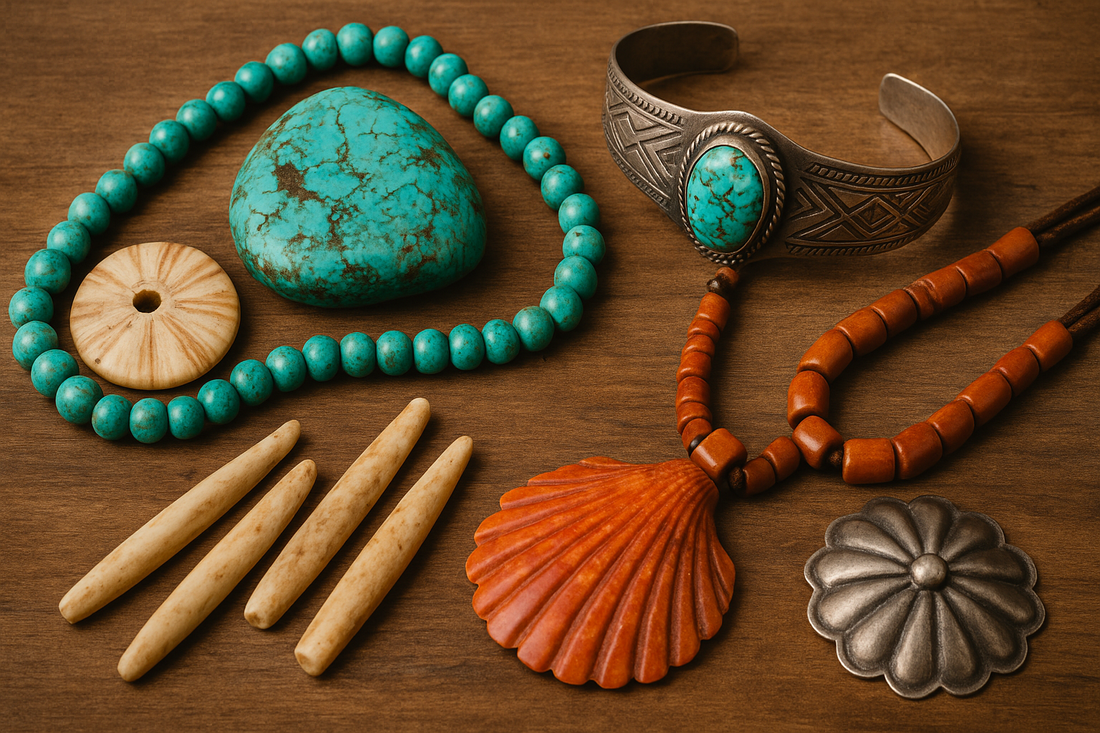
Native American Jewelry Materials
Cody ManesShare
TL;DR
Native American jewelry reflects deep cultural traditions, artistic mastery, and resourcefulness. Materials ranged from turquoise, shell, and bone to silver and traded gems. These materials not only served decorative purposes but also carried spiritual, social, and economic meaning across tribes and regions.
Key Facts
| Aspect | Detail |
|---|---|
| Earliest Materials | Bone, wood, shell, clay, stone |
| Precious Stones | Turquoise, jet, coral, garnet, pipestone |
| Metals | Copper, silver (introduced post-contact), brass, gold (less common) |
| Organic Materials | Animal teeth, claws, feathers, quills, leather |
| Trade Influence | Shells from coasts, turquoise from Southwest, silver from Spanish trade |
| Cultural Role | Spiritual power, status, identity, protection |
Q&A
Q: What was the most important stone in Native American jewelry?
A: Turquoise was the most important and widely revered stone, particularly in the Southwest among tribes such as the Navajo, Zuni, and Pueblo. Its blue-green color symbolized the sky, water, life, and abundance. Turquoise was often set into ceremonial pieces, embedded in prayer sticks, or worn as amulets believed to bring luck, protection, and harmony. With the arrival of silverworking, turquoise became paired with silver, creating an iconic art form that blended Indigenous tradition with Spanish techniques.
Q: Did Native Americans use metals before European contact?
A: Yes. Long before Europeans arrived, Great Lakes tribes and others worked native copper deposits. They hammered the metal into beads, tools, and ceremonial ornaments without smelting. While these techniques were widespread, they were limited compared to the silversmithing that developed after contact. When Spanish silver became available, Native artisans quickly incorporated it into their traditions, expanding their artistry into concho belts, rings, bracelets, and pendants. This shift marked the beginning of the globally recognized silver-and-turquoise jewelry style.
Q: Were shells only used by coastal tribes?
A: No. Shells were a highly traded resource, moving along extensive trade networks across the continent. Coastal tribes harvested abalone, conch, and wampum, which were exchanged with inland peoples for furs, turquoise, or other goods. Wampum in particular became a symbol of wealth, treaty-making, and storytelling among Northeastern tribes. Inland tribes used these shells in elaborate beadwork, necklaces, and ceremonial regalia, showing that even communities thousands of miles from the ocean valued and incorporated marine shells into their cultural expressions.
Deep Dive
Early Materials: Bone, Stone, and Shell
Before access to metals or imported stones, tribes crafted adornments from materials close at hand. Bone beads, animal teeth, and claws held symbolic meaning, often tied to hunting success, spiritual protection, or tribal identity. Stones such as soapstone and pipestone were carved into pendants or beads, while shells provided bright colors and unique textures. The presence of marine shells in inland archaeological sites shows the depth of pre-Columbian trade networks, stretching thousands of miles.
Turquoise: The Sacred Stone of the Southwest
Turquoise became one of the most iconic materials in Native American jewelry, especially for Pueblo, Zuni, and Navajo peoples. Its sky-blue hues connected it to water, sky, and life itself. Pieces often combined turquoise with jet, coral, or shell in intricate inlay patterns. Over time, turquoise jewelry also became a medium of cultural expression, with patterns and symbolism unique to each tribe. Some stones were even believed to act as protective talismans for hunters and warriors.
Metals: Copper, Silver, and Beyond
Great Lakes tribes were known for working native copper long before European arrival, shaping it into beads, pendants, and ceremonial items. After Spanish contact in the Southwest, silver became a transformative material. Navajo silversmiths adapted Spanish techniques, developing bold concho belts, bracelets, and rings. Silver provided durability and brilliance, and when paired with turquoise, it created what is now recognized globally as classic Native American jewelry.
Shells and Organic Materials
Shells such as abalone, spiny oyster, and wampum were widely valued. Spiny oyster was especially prized and rare because it came from the warm waters of the Gulf of California and required dangerous diving to obtain, making it a luxury material that added striking red, orange, and purple hues to jewelry. Wampum, made from quahog shells, carried both monetary and ceremonial significance for Northeastern tribes. Feathers, porcupine quills, and leather cords added organic beauty and were often dyed or decorated for effect. These materials reflected harmony with nature and the spiritual essence of animals.
Trade and Cultural Exchange
Trade routes shaped material diversity. Southwestern turquoise traveled east, while coastal shells moved inland. The arrival of new materials such as glass beads from Europeans expanded creative possibilities. Tribes integrated these items into existing traditions, producing hybrid forms of jewelry that blended ancient symbolism with new resources.
Spiritual and Social Roles
Jewelry was never purely ornamental. Each material carried layered meaning: turquoise for life and protection, copper for power, shells for connection to water, and animal parts for strength and spirit. Jewelry also marked social identity, clan affiliation, and ceremonial roles. Some pieces were believed to protect wearers or carry prayers to the spirit world, making jewelry a living form of cultural expression.
Sources
Furst, Jill Leslie. The Natural History of the Soul in Ancient Mexico. Yale University Press.
Dubin, Lois Sherr. North American Indian Jewelry and Adornment. Harry N. Abrams.
Taylor, Colin. Native American Arts and Crafts. Salamander Books.
National Museum of the American Indian – Smithsonian Institution
International Gem Society – Turquoise Guide
